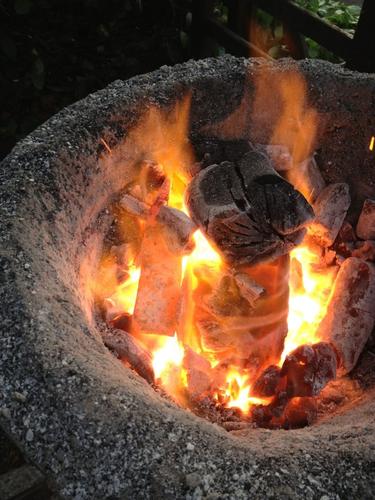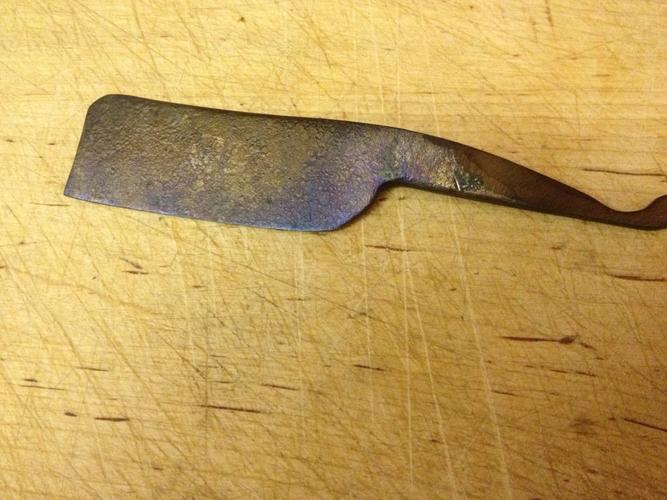Results 41 to 50 of 57
Thread: Crucible steel file
-
08-20-2013, 05:03 PM #41"My words are of iron..."


- Join Date
- Oct 2006
- Posts
- 1,898
Thanked: 995
And to second Neil's recent post...it is the alloying elements that make wootz not the crucible. But wootz is a crucible steel. Crucible cast steels can show a dendritic carbide structure if they are allowed to develop that way and the minimum iron:carbon ratio is met.
I "cleaned" some granular bits of tamahagane using a crucible and it has a very nice dendritic structure in a domed button. For that matter, most melted metals, even say copper, can show a dendritic structure if treated properly to produce those effects.
Cooking tool steels can produce alloy banding. This is another distracting effect because it can show a pattern in the steel surface but it does not make the steel wootz nor pattern welded. Blister steel reforged and welded back onto itself will show a pattern as it's turned into shear steel.
"Do you mean an African or an English swallow?" The answer is that you have to know these things...
Mostly from accumulation of information acquired from threads like this and years of repetition...and making mistakes...and being lucky. Well, you get the idea.Last edited by Mike Blue; 08-20-2013 at 05:09 PM. Reason: spelling
-
The Following User Says Thank You to Mike Blue For This Useful Post:
Neil Miller (08-20-2013)
-
08-20-2013, 05:08 PM #42"My words are of iron..."


- Join Date
- Oct 2006
- Posts
- 1,898
Thanked: 995
Bruno's right, no need for this step. Once the file hits above 400F all the hardness is gone...once the material is at forging temperature then hit it and make it what you want. The heat will have eliminated any residual stresses in the material.
There are legends about some materials requiring a low and slow approach to heating them, 52100 ball bearings comes to mind, because they were reported to pop open if the initial heating cycle was too hot and too fast. Never happened in my forge so I can't confirm this. Those are not files and no file ever gave me any grief unless I caused conditions to make it do so.
-
08-20-2013, 06:16 PM #43Senior Member



- Join Date
- Apr 2008
- Location
- Essex, UK
- Posts
- 3,816
Thanked: 3164
I like the Monty Python & The Holy Grail bridgekeeper reference, Mike!
Regards,
Neil
-
08-20-2013, 06:49 PM #44

Just to clarify something, should the blade skate a file after quenching or after it's come out of the oven for a couple of hours??
-
08-20-2013, 07:07 PM #45

After quenching. However, you may need to grind away some crud first. There may be scale on the outside, and that would not skate a file. Sand / grind until you get to the shiny stuff. From then on it should skate a file. I test this before tempering because if I need to redo the HT, I'd like to do so immediately, instead of tempering first and then having to fire up my forge again.
Tempering only makes the hardened steel softer. So if it doesn't skate a file before tempering, it sure as anything won't skate a file after.Til shade is gone, til water is gone, Into the shadow with teeth bared, screaming defiance with the last breath.
To spit in Sightblinder’s eye on the Last Day
-
The Following User Says Thank You to Bruno For This Useful Post:
Manchestertattoo (08-20-2013)
-
08-20-2013, 07:25 PM #46

I understand, well I've just ht, twice, I wasn't happy with the first results but I've sanded and buffed a little spot and it skating a file no problem. It's got a slight warp near the tail but nothing drastic, I'm not after perfection at this moment in time, and it won't interfere with honing, now to put the oven on. I bought an oven thermometer today just as peace of mind.
-
08-20-2013, 08:13 PM #47


My razor on the forge earlier, it's on the left, toe facing the camera. I found it heated up really fast, faster than I thought and I moved it to the outskirts of the forge to prevent it from getting too hot. I don't know what temp it was at just before I quenched but it was certainly demagnetised and dark orange in coloration. I'm happy with results so far, my home made forge has worked a treat and the razor skates a file. So far so good. It's in the oven now, I'm trying 225 degrees Celsius for 2 hours and then placing on a cooling rack.
-
08-20-2013, 10:16 PM #48

Well the blade has just come out of the oven, I ended up opting for 215c for 2 hours. It's mostly a bronze colour with some purple near the heel. I don't know if that's normal. Il do a test on my hone when it cool to see how it feels.

-
08-20-2013, 10:51 PM #49"My words are of iron..."


- Join Date
- Oct 2006
- Posts
- 1,898
Thanked: 995
I'd bet you're close enough to have a working razor. The surface oxides do not always mean that the steel underneath is wrong. If it's too soft, hones too easily, you will likely be better off re-hardening and tempering. I think you're close though.
-
08-21-2013, 05:46 AM #50

Looks close enough. An oven thermometer is a good idea, because they are dirt cheap, and 10 degrees can make a lot of difference during tempering. I'd try a slightly lower temperature setting next time to prevent it from going to purple. But as Mike said: give it a try.
Btw, the key to controling forge temperature is the airflow. If you find that it heats too quickly, reduce the airflow and you will get a cooler fire.Til shade is gone, til water is gone, Into the shadow with teeth bared, screaming defiance with the last breath.
To spit in Sightblinder’s eye on the Last Day


 41Likes
41Likes LinkBack URL
LinkBack URL About LinkBacks
About LinkBacks







 Reply With Quote
Reply With Quote

